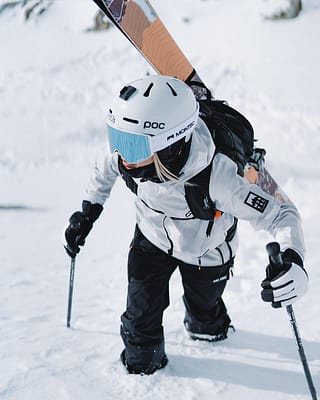The history of skiing
You will be impressed to learn the origins of skiing and the history of why strapping your feet into two long planks was an essential part of life for some, plus the invention of very key elements to the sport that make it what it is today.

When you are on a super fast chair lift, with your brand new skis and perfectly moulded boots looking down at the expertly pisted runs, with your lunch booked at a beautiful mountain restaurant, do you ever wonder… how has skiing become what it is today? Well, we did, so we thought we would share with you a brief history of skiing so that the next time when you are smashing down a run, with your UV protected goggles and brand new bindings, you can thank your great ancestors for developing such an incredible sport.
Looking at the history of skiing can teach us a lot about how to maximise our skills. We also have the winter Olympics to thank for popularising skiing and pumping cash into our favourite mountain resorts.

Ski gear and skiing's timeless tale
As you zip up your coveted men's ski bibs / women's ski bibs, lean back and allow us to carry you on a captivating voyage. Skiing equipment has evolved dramatically, particularly in the last century. In the 1800s, Norwegian craftsmen revolutionized ski design with sidecut shapes, improving turning capabilities. The 20th century saw the introduction of laminated skis, replacing solid wood construction, and by the 1950s, fiberglass skis entered the market, transforming the sport’s speed and control. In the 1990s, Salomon introduced the first twin-tip ski, igniting the growth of freestyle skiing, and modern innovations continue to refine materials for greater durability and precision. We're about to traverse centuries to unravel the engrossing history of skiing—an adventure that's as thrilling as the sport itself. Let's dive into this fascinating journey, equipped with our warmest gear and an unquenchable curiosity.
How skiing was invented
The earliest signs of skiing in history actually date back to the ice age. There are actually cave drawings found in Central Asia that show men trekking across the ice plains and through thick snow on two very long planks of wood. Back then it is thought that skiing was used for getting around, such as moving around supplies and travelling from village to village in the harsh winter months- doesn’t sound quite as fun as it is now.
It has been found in China from 8000 years ago, that the skis resembled two-metre planks of wood covered in horsehair.
Essentially, the idea will have been that this large surface area would have made trudging through thick snow easier because it makes you less likely to sink.
Where the true origins of skiing came from is always debated, as there is evidence found of skis being used in Russia, Asia, Alaska and Scandinavia. Although, it is often said that the Sami indigenous community in Sweden back in the middle ages, is where it is mostly claimed to have been invented.
It makes sense that many believed that skiing was invented in Sweden, firstly because of the notoriously harsh and snowy winters but also because you probably have never met a Swede who doesn’t ski. Going back to the Middle Ages, the Sami community were farmers who used skis to hunt and farm in the mountains and across the tundra. Of course, this was more like the Nordic and cross country skiing that we know today, rather than downhill.

The history of alpine / downhill skiing
It has been found that in the 18th century, the Norwegian and Swedish military used skiing as exercise and to test their endurance and stamina. Even today, with our incredibly light skis and our technology, we know cross country skiing is tough. Imagine being on two heavy planks of wood with no boot for support, trekking through unpisted snow- you wouldn’t want to compete with how fit the Scandinavian military must have been!
The army also began testing out downhill skiing, rather than on the flat ground. They would host competitions skiing downhill whilst shooting and other various skills. Inevitably by this point, commercialisation of downhill skiing began as word got out about the thrill of it. As this progressed, woodcarvers in Norway began to discover new shapes for the wooden skis, to help with carving and to prevent sinking into the snow, such as a pointed and curved up tip.
In the 1850’s, a Norwegian legend named Norheim developed skis that were an arched shape, with a narrow centre and wider tips- which is a classic shape that will still use today!
Beyond Norheim, figures such as Stein Eriksen, an Olympic gold medalist and pioneer of freestyle aerial skiing, played a crucial role in shaping modern ski techniques. Jean-Claude Killy dominated the 1968 Winter Olympics, bringing alpine skiing into mainstream sports culture, while innovators like Shane McConkey pushed boundaries by blending freeride and BASE jumping into extreme skiing.

The first winter Olympics in 1924
As the love of skiing became more prominent all over the world, from the Alps, America and Canada, it was time for it to become a notified sport. The more traditional cross country skiing was still more well known because lift systems had not yet been invented, so your only way up was by walking.
The first winter Olympics was in 1924 in the famous resort of Chamonix, in France. The major event had sports such as ice skating, curling and cross country skiing. It was then in the 1936 winter Olympics in Germany, that downhill skiing was showcased as a sport. There was downhill racing and dodging between poles slalom style. Conveniently, it was also in 1936 that the first chairlift was invented in Sun Valley, Idaho in the US. This was perfect timing, as skiing was becoming a popular sport and recreational activity from the Olympics, so to save ski lovers from trekking up the mountain they could now comfortably make their way to the top, with minimal effort.
Since its Olympic debut, skiing has expanded significantly within the Games. Alpine skiing became a mainstay, while disciplines like moguls, freestyle, and big air were introduced in later years. The Winter Olympics also contributed to the rise of professional ski competitions, fueling technological advancements and increasing the sport’s global reach. Today, events such as the X Games and FIS World Cup continue to push skiing’s competitive boundaries.

Skiing and what it is like today
Tourism allowed other mountain villages and towns across the US and internationally to build gondolas, rope tows and chairlifts and these became the first ski resorts we know and love today.
As the winter tour industry began to boom, the demand developed too, which brought much-needed money to build hotels, restaurants and mountain huts to feed the hungry skiers. Even early in the 20th century, some resorts had ski instructors and ski schools to give people a helping hand carving 2 metre long wooden planks.
As we know technology develops, as did ski’s that started to be made out of fibreglass rather than wood and ski boots became sturdy in plastic. Plus, the lift systems became efficient, so more keen skiers could be shipped around the mountain. All of this made skiing a lot more accessible. A major breakthrough in skiing accessibility came with the development of artificial snowmaking in the 1950s. Initially invented to combat unreliable snowfall, snow guns now allow resorts to extend ski seasons and maintain consistent conditions. In addition, the construction of terrain parks revolutionized freestyle skiing, providing dedicated spaces for jumps, rails, and halfpipes, further diversifying the sport.
Throughout the 20th century skiing as a recreational sport began to open up in resorts in Canada, the US, the Alps and even Scotland.
As skiing's popularity soared in the mid-20th century, new ski destinations emerged beyond traditional European and North American hubs. Countries such as Japan, New Zealand, and Argentina developed world-class resorts, adapting skiing to their unique landscapes. Meanwhile, artificial indoor ski domes in the Middle East and Asia now allow enthusiasts to practice year-round, demonstrating skiing’s transformation from a survival skill to a global recreational industry.
Different ways and techniques of skiing also developed, such as moguls and freestyle skiing, which then by 1989 became Olympic sports in the Winter Olympics.

FAQs
How has the design of skis evolved?
Skis have progressed from two-meter planks of wood covered in horsehair to the modern, lightweight models we use today. Advances in design over centuries have focused on improving maneuverability and reducing sinkage in snow.
When was the first ski lift invented?
The first chairlift was devised in 1936 in Sun Valley, Idaho in the US. This invention made uphill transport more convenient and played a crucial role in promoting skiing as a recreational activity.
Wrapping up
So there we have it, a brief history of skiing, our favourite pass time and obsessive hobby. It is now unrecognisable as a sport from when it first started, but we are so thankful for the enthusiasm and interest people took in it a couple of hundred years ago. We will never understand the true love for skiing that people must have had; as they tried to carve down unpisted snow with skis heavier and taller than them, strapped on by string to their leather boots, then after all that they have to walk back up the mountain to start again. Now, we have expertly crafted fibreglass skis, heat moulded secure plastic boots and lift systems that can ship 100 000’s of people an hour around a perfectly pisted mountain. We salute our early skier friends, we will be forever grateful!
Related Reading:
